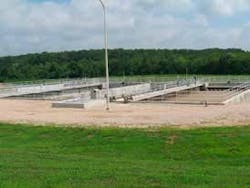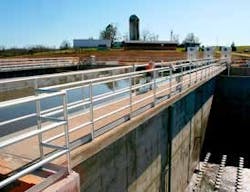Sanitaire ICEAS in Sullivan, Missouri
City officials at Sullivan, MO were notably proud in 1988 when their new aerated wastewater treatment lagoon entered operation. Within five years, however, the plant was essentially obsolete due to the reclassification of the effluent receiving stream, a rule change by the state’s regulatory agency, and apprehensions about the stability of the site’s underpinning geology. “If those concerns had existed a decade earlier, state regulators would not have approved the lagoon plant’s design and operating permit,” said City Engineer Robert Schaeffer, PE, CFM. “These were unexpected issues for a city that just a few years earlier had made a relatively large investment in the new facility.”
The City commissioned a study to review the problem and present solutions. The study identified a series of needed upgrades and concluded that Sullivan would require a different and more advanced wastewater treatment process.
Solution
Jacobs Engineering was selected from competitive proposals to serve as design consultants for the replacement plant and related upgrades. From the eight process alternatives evaluated in the study, the City selected the superior flexibility of Sanitaire’s ICEAS (Intermittent Cycle Extended Aeration) Continuous Flow sequencing batch reactor (SBR) system that utilizes a modified activated sludge biological treatment. The automated process is an enhanced variant of the activated sludge process that earned preferred specification based on the earlier study’s cost-benefit analyses of the immediate and long-range considerations. The design option offered acceptable first cost, ability to handle the varied flow, and the flexibility to be operated to achieve nutrient removal with minimal operator interaction.
“Our firm has used the Sanitaire ICEAS Continuous Flow SBR and related equipment specified at Sullivan many times before because it performs as expected.”
“The SBR technology has become increasingly common here in Missouri and is easy to operate,” according to PK Mathai, PE, the Jacobs project engineer.
The major difference between the conventional activated sludge process and a conventional SBR cycle exists in the elimination of primary settling, aeration and secondary clarification in costly separate basins. SBR’s perform these stages sequentially in the same basin which also reduces the amount of plant footprint and contingent construction costs. The advanced Sanitaire ICEAS Continuous Flow SBR takes the process further by using continuous flow without the batch interruptions during settling and decanting required in a conventional SBR operating cycle. Instead, the ICEAS system uses a time-controlled continuous repetition of three sequential phases: aeration, settle and decant. Flow equalization, oxidation, nitrification/dentrification, phosphorous removal and solids separation occur in a controlled manner within the same tank. The new-generation Sanitaire ICEAS system thereby simplifies the entire process flow.
“The installation of the Sanitaire ICEAS technology system provides the community of Sullivan with the peace of mind and comfort in knowing that the water treatment plant is, once again, meeting state regulations.”
Results
Now equipped to leave earlier concerns about the increasingly stringent wastewater regulations behind, the city of Sullivan can again be proud of its new sewage treatment infrastructure. With an intelligently designed Sanitaire ICEAS system with life-time efficiency in mind, not only does the city benefit from simplified cost-saving operations but also reliable results for the ongoing removal of nitrogen and phosphorous.
Editor's Note: Scranton Gillette Communications and the SGC Water Group are not liable for the accuracy, efficacy and validity of the claims made in this piece. The views expressed in this content do not reflect the position of the editorial teams of Water & Wastes Digest, Water Quality Products and Storm Water Solutions.

